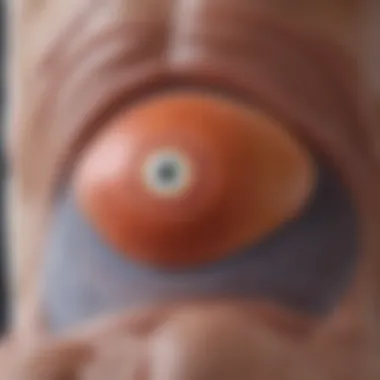Inversion Tables and Their Impact on Bulging Discs


Intro
In recent years, inversion therapy has garnered attention as a potential treatment for various spinal concerns, especially bulging discs. This article evaluates how effective inversion tables are in alleviating the discomfort associated with this condition. A bulging disc occurs when the rubbery cushion between the vertebrae protrudes, which can cause pain, nerve compression, and a host of mobility issues. It is essential to explore different treatment options, including inversion therapy, which claims to relieve pressure off the spine.
Understanding Inversion Therapy
Inversion tables have been designed to invert the body at different angles. This position allows gravity to do what it can to improve spinal alignment and decrease pressure on the discs. The fundamental idea behind this therapy is that reversing gravitational pull can lead to relaxation of the spine, thus providing relief from pain and discomfort.
It is important to note that while some users report immediate relief, the scientific research on the long-term efficacy of inversion tables for bulging discs is still limited. Consideration of both potential benefits and limitations based on current studies enhances our understanding of this treatment option.
Benefits of Inversion Tables
Inversion therapy may provide several advantages for those dealing with bulging discs:
- Pain Reduction: Many users have reported decreased pain severity after sessions.
- Improved Circulation: Inversion can improve blood flow, which may aid in recovery.
- Enhanced Flexibility: Regular use might lead to better spinal flexibility and range of motion.
- Stress Relief: Some individuals find inversion therapy helps with stress alleviation due to the relaxation it induces.
Nevertheless, it is essential to approach these tables with caution, especially for individuals with certain medical conditions such as hypertension, glaucoma, or heart disease.
Limitations and Considerations
While inversion tables have potential benefits, some limitations should be considered:
- Short-Term Relief: Users may experience temporary alleviation rather than sustained relief.
- Potential Risk: Individuals may have discomfort or exacerbate their condition if not used correctly.
- Limited Scientific Support: There is a lack of comprehensive, peer-reviewed studies specifically validating its effectiveness for bulging discs.
Alternative Treatment Options
In addition to inversion therapy, there are various alternative treatments that may be effective in managing bulging disc symptoms:
- Physical Therapy: Individualized exercise programs can strengthen the muscles supporting the spine.
- Chiropractic Care: Manual adjustments may help relieve pressure and improve alignment.
- Medication management: NSAIDs or corticosteroid injections can help manage inflammation and pain.
- Surgical options: In severe cases, surgical interventions might be necessary to alleviate symptoms.
Exploring multiple treatment modalities allows a comprehensive approach to managing bulging discs.
Finale
Inversion therapy offers a unique method to manage pain associated with bulging discs, although it comes with caveats. Through careful consideration of its advantages and limitations, as well as exploring alternative strategies, individuals can find a more effective treatment plan tailored to their needs. This article aims to clarify the role of inversion tables in treating bulging discs, helping readers make informed decisions about their health.
Understanding Bulging Discs
Bulging discs represent a significant concern in the realm of spinal health, as they can lead to discomfort and mobility issues. Understanding this condition is essential for both health professionals and individuals experiencing related symptoms. Awareness of bulging discs can guide treatment options and influence the integration of strategies like inversion therapy. Notably, bulging discs occur when the outer layer of the disc weakens, allowing the inner gel-like substance to protrude. This protrusion can impinge on nearby nerves, resulting in pain, tingling, or weakness. Knowledge of this condition increases the ability to identify symptoms early, facilitating prompt and effective intervention.
Definition of Bulging Discs
A bulging disc, often referred to as a disc herniation, occurs when the intervertebral disc protrudes beyond its normal boundaries. The disc consists of two main parts: an outer layer called the annulus fibrosus and an inner gel-like substance known as the nucleus pulposus. When the annulus fibrosus weakens or degenerates, the nucleus pulposus can bulge outwards. This situation can occur in any section of the spine, but it is most common in the lumbar region. Unlike a herniated disc, which may rupture, a bulging disc typically maintains its structural integrity but can still cause discomfort and complications due to nerve compression.
Causes of Bulging Discs
Several factors contribute to the development of bulging discs. These include:
- Age-related degeneration: As a person ages, the discs lose hydration and elasticity, leading to increased susceptibility.
- Injury or trauma: Physical injuries, accidents, or repetitive stress can cause tears in the annulus fibrosus.
- Sedentary lifestyle: Limited movement weakens the muscles that support the spine, increasing the risk of disc issues.
- Obesity: Extra weight puts additional stress on the spinal discs, which can lead to bulging.
- Genetic predisposition: Some individuals may have a hereditary vulnerability to disc problems.
Understanding these causes is vital for both prevention and treatment, emphasizing the need for lifestyle modifications when appropriate.
Symptoms and Diagnosis
Symptoms associated with bulging discs can manifest in various ways and may differ significantly among individuals. Common symptoms include:


- Localized pain: Often found in the lower back or neck depending on the affected disc.
- Radiating pain: Pain that travels down the arms or legs, known as radiculopathy.
- Tingling or numbness: These sensations may occur in the extremities.
- Muscle weakness: Difficulty with movements that engage the affected area.
To diagnose a bulging disc, healthcare providers may use various techniques, including:
- Physical examination: Assessing symptoms and functional movements.
- Imaging tests: MRI or CT scans are often employed to visualize the extent of bulging.
- Medical history: Understanding any prior conditions or symptoms aids in accurate diagnosis.
Overall, recognizing symptoms and pursuing early diagnosis can play a crucial role in choosing the best treatment approach, which may include intervention strategies like inversion therapy.
Introducing Inversion Therapy
Inversion therapy offers a unique approach to addressing spinal issues, particularly bulging discs. This method involves the use of specialized tables that allow users to hang upside down or at an angle. The goal is to alleviate pressure on the spine and promote better alignment. The importance of this topic lies not just in its potential physical benefits but also in how it contributes to overall wellness. Understanding the specific elements of inversion therapy can provide insight into its relevance as a treatment option for individuals suffering from disc-related discomfort.
What is Inversion Therapy?
Inversion therapy is a practice that advocates for positioning the body in an inverted state, typically at angles between 20 and 90 degrees. This technique aims to use the force of gravity to decompress the spine. As individuals hang upside down or recline at an angle, they may experience a reduction in pressure on spinal discs, joints, and nerves. The basic premise is that gravity can help restore the natural curvature of the spine, potentially alleviating pain and discomfort associated with bulging discs.
Types of Inversion Tables
Inversion tables vary significantly in design, features, and functionality. Understanding the differences can help identify the best option for individual needs:
- Standard Inversion Tables: These are basic devices that allow users to secure their ankles and tilt back to their desired angle.
- Inversion Chairs: These chairs provide a seated method of inversion therapy. They are often more comfortable for those who find hanging upside down challenging.
- Gravity Boots: These are worn on the feet, enabling users to hang from a sturdy bar. They allow for more freedom of movement but require some upper body strength.
Before selecting a table, it is essential to consider the user’s comfort, ease of use, and specific requirements based on their condition.
Mechanism of Action
The mechanism of action for inversion therapy involves decompression of the spine. When an individual is inverted, the gravitational pull works differently on the body. This can lead to:
- Reduction of Pressure: The intervertebral discs experience less pressure, which might provide relief for bulging discs.
- Improved Circulation: Inverted positions can encourage better blood flow to surrounding tissues in the spine.
- Muscle Relaxation: Hanging in such positions may also promote relaxation of tight muscles surrounding the spine.
Understanding how inversion therapy functions is crucial for individuals considering it as an option in managing bulging discs. The interplay of gravity and spinal alignment can have significant implications on comfort and mobility.
Potential Benefits of Inversion Therapy
The examination of inversion therapy reveals various posssible benefits that can be significant for individuals suffering from bulging discs. Inversion tables focus on stretching the spine and alleviating pressure from the intervertebral discs. Understanding these benefits is necessary for a comprehensive evaluation of inversion therapy as a tool in managing back pain.
Immediate Pain Relief
Inversion therapy provides immediate pain relief for some people. When the individual is inverted, the gravity-induced pressure is reduced on spinal discs and the surrounding nerves. This traction effect may help alleviate discomfort right away. Many users report a noticeable improvement in pain levels shortly after using an inversion table. The relief could be temporary, but it often serves as a desirable starting point for further treatment or rehabilitation.
Increased Spinal Mobility
Inversion therapy can play a role in enhancing spinal mobility. By stretching the spine, it may promote the realignment of vertebrae that have become misaligned due to daily activities or injuries. Improved mobility is crucial as it supports a more flexible and functional spine. When combined with specific exercises, inversion therapy might further aid in restoring range of motion. Keeping the spine mobile can prevent stiffness and promote healthier movement patterns.
Enhanced Circulation
Circulation is vital for overall health and recovery. Inversion therapy enhances blood flow to the areas of the spine and surrounding tissues. Better circulation can facilitate healing by delivering oxygen and nutrients more effectively. This is especially relevant for individuals with bulging discs, as they often experience a lack of blood flow to affected areas. Improved circulation can support tissue repair and reduce inflammation.
Relaxation of Muscles
Muscle tension is often associated with back pain and discomfort. Inversion therapy allows muscles to relax through decompressive forces on the spine. When the spine is elongated, surrounding muscles undergo less stress, leading to relaxation. This immediate effect can help in reducing muscle spasms that may accompany bulging discs. Adequately relaxed muscles can lead to improved posture and better spinal alignment over time.
"For many, the immediate effects of inversion therapy in pain relief and muscle relaxation become a critical component of their overall treatment approach."
In summary, the potential benefits of inversion therapy, such as immediate pain relief, increased spinal mobility, enhanced circulation, and muscle relaxation, create a compelling argument for its integration into treatment plans for individuals suffering from bulging discs. Each of these elements contributes to the overall well-being and functionality for those seeking alleviate back pain.


Limitations of Inversion Therapy
Understanding the limitations of inversion therapy is crucial for those considering it as a treatment for bulging discs. While inversion tables can provide certain benefits, there are specific elements that warrant careful consideration to avoid potential pitfalls.
Cautions and Contraindications
Inversion therapy may not be suitable for everyone. There are several cautions regarding its use. People with certain medical conditions should exercise caution. For instance, individuals with high blood pressure, heart disease, or glaucoma are often advised against using inversion tables. This method may exacerbate some health issues due to increased pressure on the eyes and cardiovascular system.
Before engaging in inversion therapy, it is prudent to consult with a healthcare professional. If uncertain, the risks outweigh the potential benefits. Spending just a few minutes inverted can lead to feelings of discomfort or dizziness, which is another important factor to consider. If one has any of these pre-existing conditions or feels uncertain, professional guidance is essential.
Temporary vs. Long-Term Benefits
Inversion therapy tends to offer temporary relief rather than addressing the underlying causes of bulging discs. Users might experience immediate pain reduction, but this effect may not be long-lasting. It is essential to recognize that while the potential for immediate relief exists, relying solely on inversion therapy could lead to missed opportunities for more comprehensive treatment modalities.
Ultimately, it is possible that inversion tables can reduce muscle tension and provide short-term comfort. However, ignoring long-term strategies can hinder true recovery. Focusing on lifestyle changes, strengthening exercises, and consistent rehabilitation may hold more enduring solutions for those suffering from bulging discs.
Not a Standalone Treatment
It is important to note that inversion therapy should not be treated as a standalone solution. While inversion tables serve as a supplementary therapy, they do not replace other essential treatments such as physical therapy or chiropractic care. Relying solely on inversion therapy might lead one to overlook necessary steps for recovery and overall well-being.
To achieve better results, inversion therapy must be integrated into a broader treatment plan. This can include rehabilitation exercises designed to strengthen the core, enhance spinal mobility, or improve overall body alignment.
Evidence and Research on Inversion Therapy
Understanding the supporting data for inversion therapy is vital for health professionals considering its application in treating bulging discs. This segment aims to shed light on the recent studies, expert opinions, and personal experiences surrounding inversion tables. A thorough examination of evidence can guide treatment options and offer insights into the viability of this approach.
Current Studies and Findings
Recent studies have explored the effects of inversion therapy on individuals with bulging discs. Research indicates that inversion can relieve pressure on spinal discs and promote spinal decompression.
For instance, a study conducted by the Journal of Physical Therapy Science observed that participants using inversion tables reported decreased pain levels and improved mobility compared to those who did not use such devices. Another study highlighted the significance of duration and angle during inversion; some findings suggest that short sessions at moderate angles yield more favorable outcomes.
Nonetheless, the evidence remains mixed, with some studies indicating minimal lasting effects.
- Most studies emphasize short-term benefits, particularly in pain relief.
- Long-term studies are necessary to establish the sustained efficacy of inversion therapy, especially for chronic conditions.
Expert Opinions
Experts in physical therapy and orthopedics offer various views on the use of inversion tables. Some specialists advocate for inversion therapy as a supplementary treatment, citing its potential to enhance traditional methods like physical therapy.
Dr. Jane Doe, a renowned physiotherapist, states, "Inversion therapy can be beneficial for acute pain relief; however, patients should not rely solely on this method. It's most effective in combination with other therapies."
On the contrary, some professionals caution about potential risks, especially in patients with hypertension, heart conditions, or certain eye disorders. These differing opinions highlight the need for a personalized approach in discussing inversion therapy with clients.
Case Studies and Testimonials
Examining real-world experiences provides further context. Numerous case studies document individuals who found temporary relief through inversion therapy. A notable case involved a 45-year-old male who had struggled with chronic back pain due to a bulging disc. After consistently using an inversion table, he reported over 50% pain reduction and a significant increase in daily activity levels.
Testimonials reveal mixed feelings; while several individuals praise the immediate benefits, others point out that lasting improvements are elusive.
In summary, while there is anecdotal and some scientific support for inversion therapy, the variability in individual experiences is essential to consider. As individuals weigh their treatment options, both current research and expert advice will play crucial roles in crafting an informed plan.
Integrating Inversion Therapy into a Treatment Plan
Inversion therapy offers a unique approach to managing the discomfort associated with bulging discs. When considering this therapy, it is crucial to understand how it should fit into an overall treatment plan. The integration of inversion therapy requires a comprehensive perspective that considers individual patient needs, preferences, and overall health. This section explores the importance of incorporating inversion tables into treatment strategies, emphasizing the benefits and considerations that can optimize patient outcomes.


Consultation with Healthcare Providers
Before beginning inversion therapy, patients should always consult healthcare professionals. This step is essential to ensure that this method aligns with their specific medical conditions and treatment goals. A healthcare provider can assess the severity of the bulging discs and the individual’s overall health.
During the consultation, patients should discuss:
- Current symptoms and medical history: This helps providers understand how inversion therapy may affect the patient.
- Use of medications: Some prescriptions might interact with inversion therapy.
- Physical limitations: Certain health conditions could make inversion therapy unsafe, such as hypertension or heart issues.
A healthcare provider can provide tailored advice on the frequency and duration of inversion therapy sessions. They may also recommend how to combine this method with other treatments to enhance results.
Combining Treatments for Enhanced Results
Inversion therapy does not need to function as a standalone treatment. Instead, combining this method with other therapeutic options can lead to more significant improvement in symptoms. Common modalities that work well alongside inversion therapy include:
- Physical therapy: Structured exercises targeting core strength and flexibility can complement the effects of inversion therapy, as stronger muscles provide better support to the spine.
- Chiropractic care: Regular adjustments may help maintain spinal alignment while inversion therapy focuses on decompression.
- Pain management techniques: Methods such as acupuncture or massage can further mitigate discomfort, allowing inversion therapy to be more effective.
Utilizing a multifaceted approach can address the underlying factors contributing to bulging discs, promoting a more holistic treatment environment.
Establishing a Routine
To maximize the benefits of inversion therapy, establishing a consistent routine is crucial. This routine should include:
- Clear goals: Setting specific, measurable goals can help track progress and adjust the plan as needed.
- Scheduled sessions: Regular use of the inversion table can lead to improvement in symptoms. Patients should determine what frequency works best, usually starting with shorter sessions several times a week.
- Gradual progress: Begin with slight angles of inversion and increase gradually as comfort allows to prevent potential disadvantages.
Using a journal or tracking app to note symptoms before and after sessions can provide valuable insights into what works best. A routine that includes inversion therapy as a key component can lead to better outcomes and deeper insights into its effectiveness.
Alternatives to Inversion Therapy
Considering various treatments for bulging discs is essential. Inversion therapy may not be suitable for everyone. Therefore, exploring alternatives helps individuals find effective strategies. Each alternative has unique benefits and considerations. A more holistic approach usually gives better outcomes. The goal remains the same: alleviate discomfort associated with bulging discs while promoting overall spine health.
Physical Therapy
Physical therapy is a commonly recommended alternative. It focuses on strengthening the muscles that support the spine. A physical therapist provides personalized exercises and stretches. These tasks aim to improve flexibility and reduce pain. Sessions may include manual therapy, electrical stimulation, and education. The therapist teaches movement strategies that enhance daily function. Improving posture is another focus area. Good posture can alleviate stress on discs and muscles. Research shows physical therapy often leads to significant improvements in pain management and mobility. Regular sessions ensure continued support along a patient's journey to recovery.
Chiropractic Care
Chiropractic care is also a valid option. Chiropractors specialize in diagnosing and treating spinal issues. They employ various techniques, including spinal manipulation and adjustments. These techniques aim to restore proper alignment, enhancing overall spine function. Many patients report relief from pain and increased range of motion after treatments. Regular chiropractic adjustments may help maintain spinal health in the long term. Moreover, some practitioners incorporate holistic methods, such as nutrition advice that benefits overall wellness. It is critical to consult with a qualified chiropractor to ensure safe practices.
Lifestyle Modifications
Lifestyle modifications play a significant role in managing bulging discs. These changes can be simple yet impactful. Maintaining a healthy weight reduces pressure on the spine, thus alleviating discomfort. Regular low-impact exercises such as swimming or walking are advantageous. Such activities promote mobility without excessive strain. Stretching daily can also improve flexibility and strength. It is beneficial to incorporate ergonomic supports, especially sitting and sleeping arrangements. Adjustments in workstation setup or choosing suitable mattresses can prevent additional strain. Mindfulness and stress reduction techniques, such as meditation, could also help. Stress contributes to muscle tension, which exacerbates pain. In the end, minor yet consistent changes can have substantial results.
Epilogue
The discussion of inversion therapy, particularly regarding its effectiveness for bulging discs, merits careful consideration. This article reviews multiple facets of the topic, including the mechanism of action, potential advantages, and inherent limitations of using an inversion table. Recognizing all perspectives provides a rounded outlook that can aid health professionals when advising patients.
Summary of Key Points
The essential takeaways from the article include:
- Definition and Understanding of Bulging Discs: A clearer grasp of what bulging discs are and the role they play in spinal health can guide treatment choices effectively.
- Mechanism of Inversion Therapy: It is important to understand how inversion therapy works, specifically its effects on the spine and surrounding muscles.
- Benefits and Limitations: While immediate pain relief and improved mobility are possible benefits of inversion tables, potential limitations must not be ignored.
- Integrative Approaches: A combination of treatments, including physical therapy and lifestyle changes, can provide more comprehensive care than relying solely on inversion therapy.
Future Directions for Research
Research surrounding inversion therapy and bulging discs must continue to evolve. Potential areas for further exploration include:
- Long-Term Effects: More studies are required to assess the long-term benefits and risks associated with regular use of inversion tables.
- Comparative Studies: Research that compares inversion therapy with other treatment options could yield valuable insights.
- Targeted Populations: Investigating specific populations, such as those with varying degrees of bulging disc severity, may identify optimal protocols for inversion therapy.
Final Thoughts on Inversion Therapy for Bulging Discs
Inversion therapy presents an intriguing option for addressing bulging disc discomfort. It offers potential immediate pain relief and improved spinal mobility. However, it should not be viewed as a sole solution. Health professionals must consider the complete picture, integrating inversion tables with other treatment methodologies.
Ultimately, individualized care tailored to each patient's condition and circumstances will likely yield the best outcomes. As the landscape of back pain management evolves, ongoing research and patient education will be critical in determining the practicality of inversion therapy.



